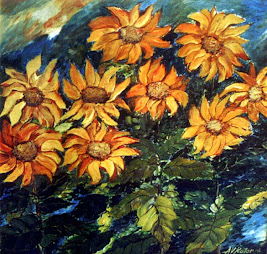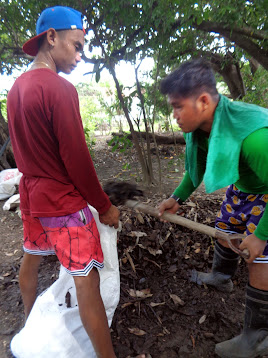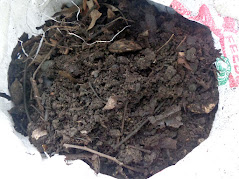Sustainable Farm Productivity through Recycling
"Everything on earth and in the universe undergoes a cycle, a beginning and an end, and in between a period of growth, stability and senescence. And the cycle is repeated ad infinitum." - avr
Idyllic Country Life
Unthreshed rice harvest and hay are piled in the open. The mandala is still popular on the countryside. The hay is utilized for roughage, mulch, compost, including fuel. (Acrylic painting by AV Rotor 2003).
I. Introduction
Everything on earth and in the universe undergoes a cycle, a beginning and an end, and in between a period of growth, stability and senescence. Yet no cycle could succeed unless it is part of an interrelationship with and among other cycles in the biological and physical world, each lending a vital role aimed at a holistic and perpetual oneness apparently designed by an unknown hand.
Cycle and recycle is the principle key to homeostasis that maintains the integrity of the biosphere, and the whole Planet Earth . Everything is tuned to a cycle - the passing of seasons, alternation of generations, food web and food chain, “natural” clocks, ecosystem seres, etc. And none of these can work without being part of a complex pattern of inter-relationships.
II. Recycle Farm Wastes
1. The moist common materials for composting in the farm are rice straw, peanut and mungo hay, banana stalk, corn stover, Azolla, ipil-ipil, wood and coconut shavings, livestock wastes and chicken droppings, pond scum, water lily and weeds.
2. Actually we get so little of the fertilizer value we put into a crop as shown by this typical fertilizer efficiencies.
· 30 to 60 % for N,
· 10 to 35 % for P, and
· 15 to 30% for K.
3. There are more nutrients removed from the soil that go into the straw than the grain. Here is a comparison. (Grain versus straw, kg nutrient/MT)
· Nitrogen: 10.5 - 7.0
· Phosphorus: 4.6 – 2.3
· Potassium: 3.0 – 17.5
· Magnesium: 1.5 – 2.0
· Calcium: 0.5 - 3.5
4. Rice straw contains 85-90 percent of potassium (K) of the biomass. Thus much greater amounts of K must be applied to maintain soil supply where straw is removed.
5. Small Water Impounding Projects (SWIP) are popular in many parts of the world where water is seasonal. Bigger ones can even generate electricity for locality.
6. Recycle crop residues to raise livestock. Our Philippine carabao is perhaps the most efficient feed converter. Of the ruminant animals it has a digestive system that can extract sufficient nutrients from roughage, enabling them to survive long dry spells.
7. Recycling with poultry makes use of farm by-products such as rice and corn bran, and reduces wastage in crops. Upgraded native chicken are more resistant than pure breeds, and are more resistant to pest and unfavorable weather. These chickens thrive on palay and corn; they forage in the filed, and glean on leftovers. They are therefore, more economical to produce, tastier and free of antibiotic residues and artificial growth hormones.
Community Garden
Residents of Barangay Valencia, a marginal community transformed an
estero of San Juan River into a vegetable garden making use of compost as fertilizer. QC
Sasso Chicken
This type of chicken is a crossbred of our own native breed with chicken from Southern France from which it got its name. Teresa Farms, Rizal owned and managed by Mr. Bobby Inocencio.
A Herd of Philippine Carabao
Carabaos beat the long hot summer along streams where they wallow in herd. (San Marcelino, Zambales)
8. Recycling with goats makes use of farm by-products and plants. Practically anything that grows in the field is food for goats, be it weed or crop. Thus they are very destructive to plants that they must be restrained in pens or tethered.
9. Recycle wastes from market and kitchen Vegetable trimmings, and waste from fish and animals require efficient collection, segregation and processing into biogas and organic fertilizer.
10. Recycling leads to the development of many products. Fruits in season that otherwise go to waste are made into table wine of different flavors. Typhoon or drought affected sugarcane make excellent natural vinegar and molasses.
11. Another recycling project is vermiculture, the culture of earthworms for game fishing and protein supplement in feeds. Earthworm casting are excellent soil additives and conditioners for ornamentals and garden crops.
12. Hydroponics or soiless culture of crops, and organic farming are becoming popular worldwide. Strict quality control is required, insuring consumers that the products were not treated with chemical fertilizers and pesticides, and should not contain a trace of toxic metals, radiation and dangerous contaminants.
13. Don’t throw away Nature’s Gifts, but tap them instead. Examples: Lantana camara as natural pesticide; oregano as natural medicine cough and sore throat; chichirica as drug against cancer; pandan as spice and condiment; eucalyptus as liniment and cold drops; bunga de China for toothpaste, lagundi for fever and flu. Many of these plants are taken for granted and many of them are considered weeds.
How to make compost with wild sunflower
Wild Sunflower (Tithonia diversifolia) has enzymes that cuts down composting time to half or third of the usual time. On a well-drained area, build a compost pile 2m x 4m, with chopped rice straw (or/with corn stover, mungo or peanut hay, others), 20cm thick, followed by chopped sunflower plant, animal manure and garden soil half the thickness of the rice straw.
Repeat making this composite layer four to 6 times until the compost is breast high. Erect 4 vertical “breathing tubes” made of perforated bamboo. This serves also as posts.
Water pile regularly, maintain 60 to 70%, cover with plastic sheet. Harvest compost after 3 to 4 weeks. Test if compost is ripe: pile has shrunk about half original volume, no foul odor, inside temperature same as outside, loamy, dark and soft.
Life’s more than the sum of its parts,
Dying as each creature departs;
Synergy its secret of unity,
Its harmony and mystery.
- AVR
Wild sunflower hastens composting of rice hay and other farm residues. Painting by AV Rotor
Kinds of Recycling
• Biological – Trichoderma, a fungus, to hasten composting
• Enzymatic – Wild sunflower in composting, urea in hay
• Mechanical – Shedding, decortication, grinding
• Fermentation – Silage, retting, biogas digester
• Burning – Rice hull ash, wood
• Combination of two or more of these methods. Ex. Mushroom production, mulching and composting using rice hay
III. Recycling in Nature
1. Lightning is Nature’s quickest and most efficient converter and recycler, instant manufacturer of nitrates, phosphates, sulfates; it burns anything on its path, recharges ions. Lightning sustains the needs of the biosphere, it is key to biodiversity.
2. Fire is the Nature’s second tool. While fire is indeed destructive, in the long run, fields, grasslands and forests are given new life by it. Fire is a test of survival of the fittest. It is the key to renewal and continuity of life.
3. Volcanoes erupt to recycle the elements from the bowels of the earth to replenish the spent landscape, so with submarine volcanoes that keep the balance of marine ecosystems.
4. The Laws of Nature always prevail with the seasons, weather and climate. They govern the life cycle and alternation of generations of organisms; the food chain, food web, and food pyramid. The same applies to long term phenomena such as Continental Drift and Ice age.
5. Naturally occurring cycles govern the physical and chemical properties pf the earth’s chemical elements and compounds, principally Carbon, Hydrogen, Oxygen and Nitrogen (CHON), which are essential to life.
6. Nature recycling of organic materials in through the action of microorganisms: bacteria, algae, protists (amoeba, diatoms), fungi, blue green algae. Fibrous materials are broken down by fungi. Other than roughage and fuel, rice hay is used as substrate for mushroom growing. The spent materials decompose easily into organic fertilizer.
7. Recycling in nature through the action of microorganisms. Top left, clockwise: bacteria (dark sports) attacking a cell; algal bloom (note evolution of CO2 gas); phosphate bacteria glow in the dark; protists (amoeba, diatoms, blue green algae). Recycling of fibrous materials with fungi. Other than roughage and fuel, rice hay is used as substrate for mushroom growing. The spent materials decomposes easily into organic fertilizer.
8. Recycling by animals also helps in controlling the destructive ones such as the mosquito, which is food of fish, spider and bat.
9. Nature’s nutrient converters. Simple life forms such as lichens, algae, mosses and ferns silently work on inert materials, convert them into nutrients for higher organisms.
10. Nature’s recycling with waterways Mekong river in Vietnam (below), Pasig River in the Philippines, Great Britain, Danube and Rhine in Europe, the Nile, Mississippi, Amazon, Yangtze, Tigris-Euphrates. Rivers, lakes, swamps, basins – they provide many basic needs of man. They are arteries of life, the ecological bridge between the living and the non-living world. It is said that no civilization exists without a river.
The 7 Rs in Waste Management
Recycling is integrated in a total management system.
1. Reduce - plan to limit potential waste
2. Replace with environment-friendly materials
3. Regulate depends on effective governance
4. Recycle - re-use in original or new form.
5. Replenish. “Pay back” what you get from nature.
6. Reserve for tomorrow, next generation, posterity.
7. Revere - reverence for life, respect creation.
IV. Non-biodegradable and Toxic Wastes
1. Recycling is not recommended where pollution is heavy and unabated such as this mudflat. Silt in clean environment is excellent garden soil.
Mudflat: sediments of debris, silt, garbage and other pollutants
2. Watch out for toxic materials
• Toxic metals: Cadmium, Mercury, Lead
• Hospital and medical wastes, including radioactive materials
• Pesticide residues, especially dioxin
• Industrial wastes, like acids, Freon, alkalis
Pollution is a serious threat to wildlife, second to the destruction of natural habitats.
3. Oil Spill Recycling? Not with hydrocarbon compounds; not in the case of oil spill. The Petron oil spill in Guimaras in 2005 destroyed thousands of hectares of marine and terrestrial irreversibly upsetting ecosystems and depriving the residents of their livelihood.
4. Chemical pesticides are concentrated in food chains by biological magnification
Mandala, European style, a painting by Vincent van Gogh
Jatropha for Biofuel
Highly poisonous plant Jatropha or Tubang Bakod for biogas production poses danger to environment. Left to right: Dr, Domingo Tapiador of FAO-UN, veteran journalist Dell Grecia, and Dr. Abe V. Rotor
Agro-Ecology Model
The traditional country home: a painting by AV Rotor
--------------------------------------------------------------------------------
“How wonderful is creation when we realize in a miniscule
the universality of the simple linked to the complex,
where every living thing is part of life’s interrelating;
like a chain, its strength shared by each link cooperating.” AVR
---------------------------------------------------------------------------------
Recycling: Key to Self-reliance, Homeostasis and Sustainability
1. Recycling helps moderate global warming, the buildup of heat in the environment from increased human activity in a postmodern world. Recycling offers opportunity to everyone in doing his part in combating global warming, and the effects of El Niño
2. Recycling corrects the growing imbalance of acidity and alkalinity of the soil and water (pH value). Too acidic or alkaline conditions lock up available nutrients useful to life, affect the physiology of living things. Recycling buffers acid rain which is responsible for the death of whole ecosystems like forests, coral reefs, and destruction of fields, pasture, seas, and even valuable pieces of art.
3. Recycling is not ideal where monoculture is practiced, thus it aims to lead farming back to a system of multiple cropping and integrated farming. Tri-commodity farms – production of crops, animals and fish – are best suited to recycling, and guarantee the gains in recycling itself.
4. Self-contained farming is therefore an important condition for recycling to succeed - and that recycling in return insures the success of the other. It is in principal and practice imitating nature. There is no formula in keeping our environment healthy and balance. This is indeed the answer to spiraling prices if farm inputs, and the decreasing productivity of farms. Lightning
Nature’s quickest and most efficient converter and recycler, instant manufacturer of nitrates, phosphates, sulfates; burns anything on its path, recharges ions. Lightning is key to Biodiversity; it humbles the spirit as well.
5. E. Schumacher pointed out in his thesis and book, Small is Beautiful, that being small after all, is the alternative to corporate failure, the inability of bigness to adjust to change, analogously like “dinosaur syndrome”, which explains the failure of these primitive giants to survive abrupt change of their environment.
Recycling with Fire.
Fire is indeed destructive. In the long run, fields, grasslands and forests give way to new life, spread of pests are controlled It is the key to renewal and continuity of life.
I am reminded of a friendly encounter with an old man living by a pocket lake atop Mt Pulog in Benguet in one of my biology field trips. It is a local scenario of Henry David Thoreau, the great American philosopher who left town to live alone by the Walden Pond in a nearby forest.
Sitting by the lake with Ka Inti I asked him, “What is the best way to preserve nature?”
“Leave Nature alone.” He quipped.
I expected a different answer because I thought man is the guardian and custodian of living things - and all creation for that matter.
Ironically man has not succeeded in his obligation as guardian of the earth. Direct confrontation between man and nature has been without respite throughout the ages – from the long period of hunting-gathering, shifting to agriculture, and ultimately leading to today’s accelerating industrialization.
Modern living or the so called good life, has farther wedge nature and man apart. Before it was nature that was the “enemy” of man; now it is man who is nature’s enemy. I wrote this verse to highlight it as a challenge to all of us.
“The ultimate test of any civilization
is not in its inventions and deeds;
but the endurance of Mother Nature
in keeping up with man’s endless needs.” - AVR
The wisdom of the old man by the lake is deep. Leaving nature alone is not to be literally interpreted. Rather it is in knowing and respecting the laws and rules of Nature, and not in insisting ours. This is where the conflict lies. Similarly Thoreau saw that the problem lies in human nature - of not responding to his conscience, of not listening to his inner self - (The Little Prince in Antoine de Saint-Exupery’s novel, to quote
“It is only through the heart that one speaks clearly.
“What is essential is invisible to the eye.”
Nature’s ways are God’s ways, and God’s ways are Nature’s ways. Thus the ways of Nature and Man are one. ~



























































